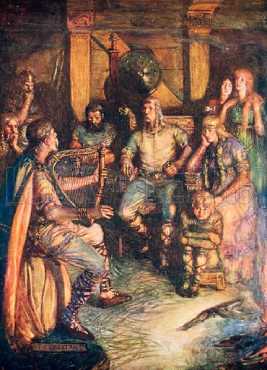Geoffrey Chaucer (1340?- 1400) is rightfully called the first prominent figure of English Literature who transformed not just literature but also the language of England. His political and literary career, spanning for almost fifty years is categorized into three distinct phases. He saw the reign of three English kings, served as a national figure and explored the continent thereby absorbing the earliest essence of the Italian Renaissance heralded by Dante, Petrarch and Bocaccio. He grew up in the fearful times of the Black Death, joined the court at the young age of seventeen and went on to fight in the Hundred Year’s War against France. It was during this time that he came under the influence of the French literature and culture and eventually created remarkable pieces himself. After this phase, which lasted for about thirty years, he came under the influence of Italian writers, thereby entering the Italian phase of his career, spanning for about fifteen years. Finally, he created his masterpiece “The Canterbury Tales” in his last phase, the English phase. The phases are approximations and overlapping as well and this division should not be seen as absolute water-tight compartments.

The French Period: (Upto 1370)
For Geoffrey Chaucer, French was a language as familiar as English. He came in close contact with the courtly love tradition of his contemporary French poets. The best-known work of Chaucer’s French period is Romaunt of the Rose, a translation from the French Roman de la Rose, a medieval dream allegory. The original work established a code of behaviour, set a value on chastity and ordered a subordinate role for women. Allegorical characters such as Love, Hate, Envy, Jealousy, Idleness, Sweet Looks abound the story of the rose growing in a mystic garden, representing a beautiful lady. While translating, Chaucer had put in some original English touches.
Chaucer’s first narrative poem, The Book of the Duchess (Originally called Dethe of Blanche the Duchesse), follows the convention of dream allegory. The poem, written in 1369, on the death of Blanche, Duchess of Lancaster, to celebrate her glory and console her bereaved husband John of Gaunt (Chaucer’s patron and Duke of Lancaster). The poem served the twin purposes of eulogy and elegy. Chaucer successfully infuses elements of psychological and dramatic liveliness into this visionary elegy which has a trancelike quality about it.
Chaucer wrote a few other poems during the French period. “Compleynte to Pite” is a graceful love poem. “ABC” is a prayer to the virgin, translated from the French of a Cistercian monk. Its verses begin with the successive letters of the alphabet. He also wrote a number of ballads and miscellaneous verses.
The Italian Period (1370-1385)
The chief work of the Italian period is Troilus and Criseyde, a poem of eight thousand lines. It brings together the story of Trojan war, the Italian poetic version of that story and Boethius’s philosophical work of the 6th Century, The Consolation of Philosophy. It is considered to be the first real novel in English. Chaucer uses his source, Boccaccio’s Il Filostrato but changes the simple fast-moving Italian story of love and betrayal into a multidimensional work. He enriches the narrative, set in the backdrop of the Trojan war, through excellent art of characterization and incorporation of the ideals of his own society and country.
“The Hous of Fame” (1374-85) is one of Chaucer’s unfinished poems. It is divided into three parts. The influence of Dante’s Divina Commedia is seen in the second and third parts. In the poem, the author is carried away in a dream by a great Eagle from the brittle temple of Venus. In this poem, Chaucer becomes a participant in his own writing. He brings together aspects of love which were to inspire poets down the ages following Chaucer. He uses the new verse form of rhyme-royal stanza in the poem.
The third great poem of the Italian period, The Legende of Goode Wimmen, describes some of the famous classical women who sacrificed themselves for love. Chaucer returns to the love-vision for his framework and narrates the stories of women like Cleopatra, Medea, Lucrece, Ariande, Philomela and others. Although Chaucer might have had a grander plan to include many more legends, he left his work unfinished in the middle of the ninth legend. He was inspired by a feeling to counteract his earlier presentation of woman’s betrayal in Troilus and Criseyde, in a way to atone for his negative presentation of women.
The Parliament of Fowls, also written in the dream convention, has elements from both Dante and Boccaccio. The poem is a celebration of St Valentine’s Day, possibly prompted by the royal courtship of King Richard II and Anne of Bohemia in 1380. The poem is a humorous and at times philosophical exploration of the idea of love.
The English Period: (1385-1400)
The English period in Chaucer’s life is filled with his grand and most famous Canterbury Tales. The plan of the book was to represent a wide range of people across social standings. Some thirty pilgrims (ranging from a high-class knight to the poorest ploughman) decide to tell stories to each other to enliven their journey to the shrine of Thomas Beckett in Canterbury. Their assemblage starts from Tabard inn. It was decided that each pilgrim would narrate two stories in their forward journey and two in their return journey. Originally, the plan was to write one hundred and twenty stories, however, only twenty-four were written. The stories cover a wide range of themes starting from love and chivalry, travels, religious figures, adventures, animal fables, allegories and even satires. Two of the stories were written in prose. The characters were not glamourised heroes and divine figures but common men and women with ordinary human virtues and foibles. Among the many characters, the most popular ones are Harry Bailey (the merry host of Tabard Inn), the remarkable Wife of Bath, Madame Eglantine, the kindly ploughman, the gentle knight and the parish priest. Chaucer infuses his writing with such a detailed and empathetic presentation of ordinary human experience that he set a new standard for literature.
Geoffrey Chaucer’s Style and Metre
In the Canterbury Tales, Chaucer uses lines of ten syllables in couplets. In Troilus and Criseyde, he uses the Rime Royal, arranged in seven-line stanzas. He used the eight-syllable line with four accents, the lines riming in couplets in “the Book of the Duchess”. These three principal metres are observed in the works of Geoffrey Chaucer. The principal essence of Chaucer’s poetry is musicality. He transformed the existing midland dialect into a full-fledged language capable of musical lyricism.
Additional Reading
Anglo-Norman Period: 5 Most Popular Literary Works
Anglo-Norman Period, which spans between 1066 AD and 1350 AD, started with the Norman Conquest. There was a massive influence…
Read MoreAnglo-Saxon Age: Life and Literature
Anglo-Saxon Age is considered to be the starting point of British literature. The original inhabitants of England since the iron…
Read MoreAnglo-Saxon Heroic Poetry and Elegies
Anglo-Saxon heroic poetry is seen to connect intimately with the spirit and culture of Germanic races. Historically, we have very…
Read More




